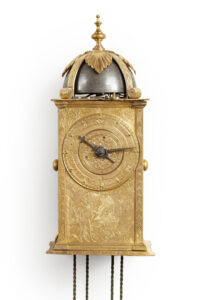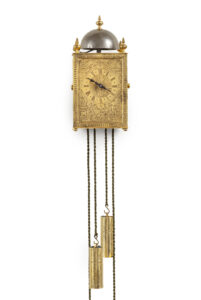RENAISSANCE AUTOMATON FIGURE CLOCK Ca. 1600 Germany
M&R217
RENAISSANCE AUTOMATON FIGURE CLOCK
Circa 1600
Germany
Movement
The spring-driven, day-going, three-train movement is constructed between brass plates. The going train has a spring barrel with gut fusee and hairspring balance, whilst the quarter-striking train indicates the quarters on a small bell (four times), at the hour followed by the hours on a larger bell. The automaton is activated by the hour striking train, setting the rider in motion, who spurs the dromedary with a whip. When the clock is running, the dromedary’s eyes move via a connection to the balance. The bells are situated next to each other on the bottom plate. Here is also the countwheel, partly hidden by the large bell, which has Arabic numerals, a beautifully engraved rose in the centre and a blue steel pointer, which indicates the hour struck. Opposite, partly underneath the large bell, is a small chapter ring with a blue steel pointer, indicating the position of the quarter-striking train. There is also a regulation disc to adjust the going train. The clock is wound from the bottom.
Dial
There is a small silver dial situated on the gilt brass base of the clock. It has a Roman chapter ring with half-hour divisions, surrounded by a gilt brass ring with Roman quarter-hour numerals, Arabic five-minute and minute divisions. The centre is beautifully engraved depicting scroll leaf and floral motifs, with a vase with flowers, which is flanked by two butterflies, near the XII. The time is indicated by a pair of blued-steel hands.
Case
The brass case depicts a dromedary with rider. The reins and straps of the saddle are made of silver and silvered copper. The fire gilt brass rider holds a whip in his right hand. The dromedary is situated on an octagonal, ebony-veneered wooden base. All sides are decorated with silvered brass ornaments, the whole resting on eight feet.
Duration 1 day
Height 43 cm.
Width 30 cm.
Depth 25.5 cm.
Literature & Media
Apart from this dromedary, there are three similar figure clocks in the shape of a dromedary known:
Maurice and Mayr, Die Welt as Uhr, Munich, 1980, p. 255
Klaus Maurice, Die deutsche Räderuhr, Band II, Munich, 1976, Fig. 298 and 299
D. Roberts, Mystery, Novelty and Fantasy Clocks, Atglen, 1999, p. 37.
Winters, Bliss, Avery and Bowman, A Renaissance Treasury, The Flagg Collection of European Decorative Art and Sculpture, Manchester, USA, 1999, pp. 38 and 39.
Milwaukee Art Museum collection: http://collection.mam.org/details.php?id=4973,














